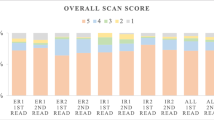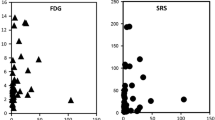Abstract
This study evaluated the use of image fusion in the preoperative staging of neuroendocrine tumors (NET) of the pancreas and the gastrointestinal tract (GIT). Thirty-eight patients suffering from a metastasized NET with location of the primary in the pancreas (n=15) or the GIT (n=23) were examined by somatostatin receptor scintigraphy (SRS) and computed tomography (CT). Consecutive image registration and fusion were performed using custom-built software integrated in AVS/Express (Advanced Visual Systems, Waltham, MA, USA). Registration was performed by a voxel-based algorithm based on normalized mutual information. Image fusion was feasible in 36/38 patients. A total of 87 foci were assigned to anatomical regions (e.g. gut, pancreas, liver, lymph node or others) by two independent observers in both SRS and SRS/CT fusion images. The assignments used a binary ranking system (1=”definite”, 0=”not definite”). These results were then retrospectively compared to the classification of the foci, based on postoperative histology or clinical follow-up. Imaging by SRS allowed a definite anatomical assignment in 57% (50/87) and 61% (53/87) of all lesions in the case of observers A and B, respectively. Image fusion improved the topographic assignment to 91% (79/87) and to 93% (81/87). The number classified as “definite” by both observers increased from 54% (47/87) to 86% (77/87). The increase in definite assignments was highly significant for both observers (P<0.0001 for each). In the case of foci classified as liver metastases, image fusion allowed improved assignment to the corresponding liver segment from 45% (18/40) to 98% (39/40) and from 58% (23/40) to 100% (40/40) by observers A and B, respectively. Furthermore, the improved assignment of foci classified as lesions by image fusion was relevant for therapy in 7/36 patients (19%). Therefore, the image fusion technique presented herein appears to be a very useful method for clinical routine.


Similar content being viewed by others
References
Debray MP, Geoffroy O, Laissy JP, Lebtahi R, Silbermann-Hoffman O, Henry-Feugeas MC, Cadiot G, Mignon M, Schouman-Claeys E. Imaging appearances of metastases from neuroendocrine tumours of the pancreas. Br J Radiol 2001; 74:1065–1070.
Shi W, Johnston CF, Buchanan KD, Ferguson WR, Laird JD, Crothers JG, McIlrath EM. Localization of neuroendocrine tumours with [111In]DTPA-octreotide scintigraphy (Octreoscan): a comparative study with CT and MR imaging. QJM 1998; 91(4):295–301.
Krenning EP, Kwekkeboom DJ, Bakker WH, et al. Somatostatin receptor scintigraphy with [111In-DTPA-d-Phe1]- and [123I-Tyr3]-octreotide: the Rotterdam experience with more than 1000 patients. Eur J Nucl Med 1993; 20:716–731.
Slooter GD, Mearadji A, Breeman WA, Marquet RL, de Jong M, Krenning EP, van Eijck CH. Somatostatin receptor imaging, therapy and new strategies in patients with neuroendocrine tumours. Br J Surg. 2001; 88:31–40.
Ricke J, Klose KJ, Mignon M, Oberg K, Wiedenmann B. Standardisation of imaging in neuroendocrine tumours: results of a European delphi process. Eur J Radiol 2001; 37:8–17.
Hosten N, Kreissig R, Puls R, Amthauer H, Beier J, Rohlfing T, Stroszczynski C, Herbel A, Lemke AJ, Felix R. Fusion von CT- und PET-Daten: Methoden und klinische Bedeutung am Beispiel der Planung der laserinduzierten Thermotherapie von Lebermetastasen. Rofo Fortschr Geb Rontgenstr Neuen Bildgeb Verfahr 2000; 172:630–635.
Hosten N, Lemke AJ, Wiedenmann B, Böhmig M, Rosewicz S. Combined imaging techniques for pancreatic cancer. Lancet 2000; 356:909–910.
Maintz JB, Viergever MA. A survey of medical image registration. Med Image Anal 1998; 2:1–36.
Israel O, Keidar Z, Iosilevsky G, Bettman L, Sachs J, Frenkel A. The fusion of anatomic and physiologic imaging in the management of patients with cancer. Semin Nucl Med 2001; 31:191–205.
West J, Fitzpatrick JM, Wang MY, et al. Comparison and evaluation of retrospective intermodality brain image registration techniques. J Comput Assist Tomogr 1997; 21:554–566.
Wagenknecht G, Kaiser HJ, Büll U. Multimodale Integration, Korrelation und Fusion von Morphologie und Funktion: Methodik und erste klinische Anwendungen. Rofo Fortschr Geb Rontgenstr Neuen Bildgeb Verfahr. 1999; 170:416–426.
Studholme C, Hill DLG, Hawkes DJ. Automated three-dimensional registration of magnetic resonance and positron emission tomography brain images by multiresolution optimisation of voxel similarity measures. Med Phys 1997; 24:25–35.
Studholme C, Hill DLG, Hawkes DJ. An overlap invariant entropy measure of 3D medical image alignment. Pattern Recognition 1999; 32:71–86.
Rohlfing T, Beier J. Improving reliability and performance of voxel-based registration by coincidence thresholding and volume clipping. In: Hawkes DJ, Hill DLG, Gaston R, eds. Proceedings of medical image understanding and analysis. London: Kings College; 1999:165–168.
Rohlfing T. Multimodale Datenfusion für die bildgesteuerte Neurochirurgie und Strahlentherapie. PhD thesis, Technische Unversität Berlin, 2000.
Couinaud C. Le foie. Etudes anatomiques et chirurgicales. Paris: Masson, 1957.
Brunner E, Domhof S, Langer F. Nonparametric analysis of longitudinal data in factorial experiments. Hoboken, NJ: Wiley, 2002.
Kulke MH, Mayer RJ. Carcinoid tumors. N Engl J Med. 1999; 340:858–868.
Wiedenmann B, Jensen RT, Mignon M, Modlin CI, Skogseid B, Doherty G, Oberg K. Preoperative diagnosis and surgical management of neuroendocrine gastroenteropancreatic tumors: general recommendations by a consensus workshop. World J Surg 1998; 3:309–318.
Modlin IM, Sandor A. An analysis of 8305 cases of carcinoid tumors. Cancer 1997; 79:813–829.
Hofler H, Stier A, Schusdziarra V, Siewert JR. Klassifikation der neuroendokrinen Tumoren des Gastrointestinaltrakts und des Pankreas und ihre therapeutische Relevanz. Chirurg 1997; 68:107–115.
Pascher A, Steinmuller T, Radke C, Hosten N, Wiedenmann B, Neuhaus P, Bechstein WO. Primary and secondary hepatic manifestation of neuroendocrine tumors. Langenbecks Arch Surg 2000; 385:265–270.
Schmidbauer S, Ladurner R, Juckstock H, Trupka AW, Mussack T, Hallfeldt KK. Die operative und adjuvante Therapie neuroendokriner Tumoren des Gastrointestinaltrakts und ihrer Metastasen. Chirurg 2001; 72:945–952.
Patel YC. Somatostatin and its receptor family. Front Neuroendocrinol 1999; 20:157–198.
Anthony LB, Martin W, Delbeke D, Sandler M. Somatostatin receptor imaging: predictive and prognostic considerations. Digestion 1996; 57 Suppl 1:50–53.
Kisker O, Weinel RJ, Geks J, Zacara F, Joseph K, Rothmund M. Value of somatostatin receptor scintigraphy for preoperative localization of carcinoids. World J Surg 1996; 20:162–167.
Sugimoto E, Lorelius LE, Eriksson B, Oberg K. Midgut carcinoid tumours. CT appearance. Acta Radiol 1995; 36:367–371.
Even-Sapir E, Keidar Z, Sachs J, Engel A, Bettman L, Gaitini D, Guralnik L, Werbin N, Iosilevsky G, Israel O. The new technology of combined transmission and emission tomography in evaluation of endocrine neoplasms. J Nucl Med 2001; 42:998–1004.
Weber DA, Ivanovic M. Correlative image registration. Semin Nucl Med 1994; 24:311–323.
Mongioj V, Brusa A, Loi G, Pignoli E, Gramaglia A, Scorsetti M, Bombardieri E, Marchesini R. Accuracy evaluation of fusion of CT, MR, and SPECT images using commercially available software packages (SRS PLATO and IFS). Int J Radiat Oncol Biol Phys 1999; 43:227–234.
Perault C, Schvartz C, Wampach H, Liehn JC, Delisle MJ. Thoracic and abdominal SPECT-CT image fusion without external markers in endocrine carcinomas. The Group of Thyroid Tumoral Pathology of Champagne-Ardenne. J Nucl Med. 1997; 38:1234–1242.
Lester H, Arridge SR. A survey of non-linear medical image registration. Pattern Recognition 1999; 32:129–149.
Acknowledgements
This study was supported by Deutsche Forschungsgemeinschaft as part of the project Graduiertenkolleg 331: “Temperaturabhängige Effekte in Therapie und Diagnostik” (Grant No. GRK331–1/97). T.R. was supported by the National Science Foundation (USA) under Grant No. EIA-0104114.
Author information
Authors and Affiliations
Corresponding author
Rights and permissions
About this article
Cite this article
Amthauer, H., Ruf, J., Böhmig, M. et al. Diagnosis of neuroendocrine tumours by retrospective image fusion: is there a benefit?. Eur J Nucl Med Mol Imaging 31, 342–348 (2004). https://doi.org/10.1007/s00259-003-1379-7
Received:
Accepted:
Published:
Issue Date:
DOI: https://doi.org/10.1007/s00259-003-1379-7




